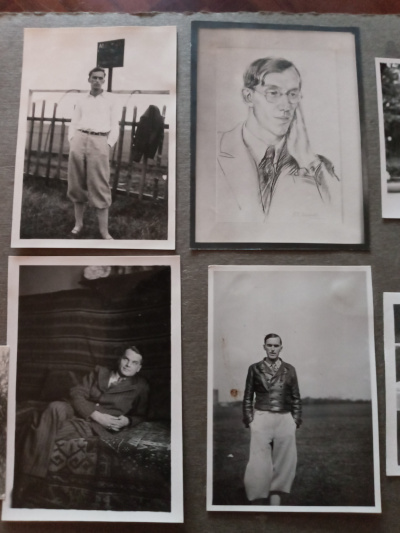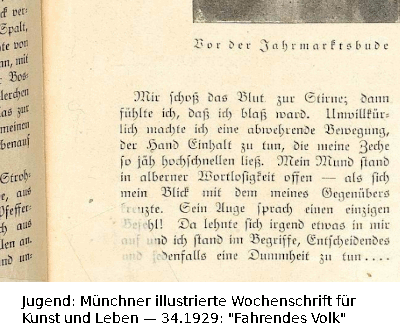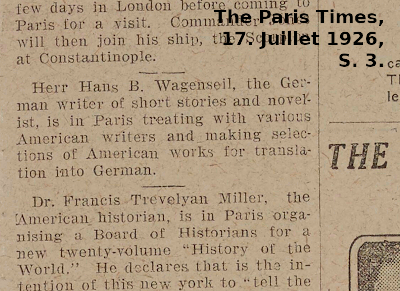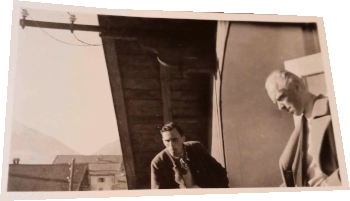Kurt Wagenseil, Hans B. Wagenseil
En français: Brève introduction | Magyarul: rövid bevezető | På svenska: Kort introduktion | краткое введение | In italiano: Breve introduzione | En español: Breve introducción | 日本語: はじめに | 中文:简介
 These pages are my research project about my grandfather Kurt Wagenseil (1904-1988) and his brother Hans B. Wagenseil (1894-1975), placed in a former existing genealogy page of my family. They were both writers and especially translators, mostly from English and French, but there are also translations from Swedish, Hungarian, Italian, Spanish, Russian, Dutch, Finnish and Icelandic. But translations from these last four languages are signed with more than one translator. Most known are the books, so Kurts translations of George Orwell's "Nineteen Eighty-Four" and the works of Henry Miller, Hans B.'s translations of the works of Vita Sackville-West, Virginia Woolf, Pearl S. Buck and John Steinbeck.
These pages are my research project about my grandfather Kurt Wagenseil (1904-1988) and his brother Hans B. Wagenseil (1894-1975), placed in a former existing genealogy page of my family. They were both writers and especially translators, mostly from English and French, but there are also translations from Swedish, Hungarian, Italian, Spanish, Russian, Dutch, Finnish and Icelandic. But translations from these last four languages are signed with more than one translator. Most known are the books, so Kurts translations of George Orwell's "Nineteen Eighty-Four" and the works of Henry Miller, Hans B.'s translations of the works of Vita Sackville-West, Virginia Woolf, Pearl S. Buck and John Steinbeck.
But the heart of their work consists out of short stories. They translated stories by William Somerset Maugham, H.G. Wells, Jean Cocteau, André Maurois, Paul Morand, and many more interesting persons. Instead of working with translation agencies they started with personal friendships. But much of their story is laying in the shadows. As I began my research there was only a book bibliography list and next to obituaries in newspapers one biographical document about Kurt, an interview in the "Börsenblatt" 1976: "Der Mann, der Henry Miller nach Deutschland brachte" ("The man who brought Henry Miller to Germany"). About Hans B. there was a little bit in books about "Worpswede", an artist's commune, where he lived around 1921/22, and about Thomas Theodor Heine, painter at the magazine "Simplicissimus", because of his friendship to Heine's daughter Johanna Heine in the 1930s.
The "Börsenblatt" interview mentioned Kurt's time in the concentration camp Dachau, but the story was narrowed. Later I would find reparation trial files, he won the process after appeal, and one aspect of this process was the question, whether he was interned because of political reasons, because he brought the "Braunbuch" ("The Brown Book of the Reichstag Fire and Hitler Terror") along from England. But the documents of the Nazis go beyond that.
Harold Nicolson's intervention could free Kurt from the concentration camp, in December 1935, after nine months. As I know from letters like those to Henry Miller, he went into Exile to England 1936, came back because of the illness of his mother in 1938 and came in jail again 1939. After that they took him his passport and gave him the order to work for a publishing company, called "Deutscher Verlag", "the German publishing company", in 1940. The letters to Henry Miller, as archived in his papers in California, start 1947 with an amazing dialogue, because the young family of Kurt survived after the war with care parcels from Henry Miller and other friends.
 If the "Börsenblatt" interview tells right, Kurt met Henry Miller first around 1934 in Paris, and he got the German translation rights of his works. But the circumstances made it impossible to use them. After the war he could publish the German translations of "Tropic of Capricorn" and "Tropic of Cancer" in 1953 at Rowohlt. Nineteen years later. The letters between Kurt and Henry are more than hundred pages, and go forward until 1960.
If the "Börsenblatt" interview tells right, Kurt met Henry Miller first around 1934 in Paris, and he got the German translation rights of his works. But the circumstances made it impossible to use them. After the war he could publish the German translations of "Tropic of Capricorn" and "Tropic of Cancer" in 1953 at Rowohlt. Nineteen years later. The letters between Kurt and Henry are more than hundred pages, and go forward until 1960.
But there are much more letters. First I tried to organize copies of them. I found them not only at the home of a relative. There are letters in archives in the U.S., in Canada, in England, in France, in Germany and in Switzerland. For now. They tell about Hans B., the Internationale Anti Militaristische Vereniging ("De Wapens neder", 1919) and the War Resisters' International (Armin Theophil Wegner around 1921), and the revolution in Munich (Zenzl Mühsam to Erich Mühsam, around 1920), the Wagenseil brothers and the Bohemian World of Paris (the French letters to Marcel Jouhandeau 1927 and to René Boylesve before 1926, André Germain as a reference in a letter to Ephraim Frisch 1925, the letter from Nancy Cunard to Kurt, written between 1926 and 1928), and the prequel to Sissinghurst (letters from Virginia Woolf or Vita Sackville-West about the Wagenseils around 1928), there shall even exist a letter from B. Traven to Kurt 1932. Some texts in newspapers could be found because Kurt mentioned them in his letters.
A curisosity is, that there are only a few small texts and two book translations with the name of Kurt before 1946. In the reparation trial files he concedes that he also used the name of his brother, but in reality a good part of the translations, especially those from French, are probably made by Kurt.
The cutout on the left is from the illustrated magazine for art and life "Jugend" ("Youth"), in 1929, with a short story "Fahrendes Volk" ("Traveling people") by Hans B. and a painting "In front of the fairground booth". The four photographies show Hans B. below left, Kurt above left and below right, the drawing is the Canadian art dealer Douglas Duncan, a friend of Kurt, he met in Paris.
It is even harder to reconstruct the life stations of Hans B. They are both born in Munich. Hans visited different schools. He was in the same school class like the painter Hans Reichel, who also joined the movements around Erich Mühsam and Ernst Toller. Later Reichel would met Henry Miller in Paris, too, and they became friends. For around the time after school Hans B. went to a circus, with a bicycle act. Following a short biography, printed 1947 in the magazine "Karrussell", he visited the commercial school later, but the escape was motivated in contradiction to the father's wish to chose this kind of way of life. The father Armin Wagenseil was very ill, and died days later, in 1913. Hans B. came back, but after the marriage with Romaine Taylor, an American, in 1915, he refused military service and went to jail. Kurt, in 1913 just nine years old, got a legal guardian, Paul Wassermann. After school Kurt finished a training at the company of Karl Adler in Munich. After Worpswede Hans B. was at the artist's commune in Berlin-Wilmersdorf, in 1926. And in the summer times he was with Kurt in Paris, as proofed by letters and newspapers for Americans in Paris of that time. Kurt began other trainings at a hotel in Munich and a publishing company in Hamburg. The hotel he specified in his curriculum vitae, the publishing company he mentioned in the reparation trial files. Finally he worked 1928-31 for the galery Justin Thannhäuser in Berlin and Luzern as an art dealer.
 After addresses like "6, Rue Broissonade, Paris XIVe" in 1927 or "Cap d'Antibes, Villa Les Pins" in 1928, Hans B. lived during the NS time mostly in Munich or in a cabin at the lake Ammersee. Only from 1937 there is a letter with a sender address "Savoy Hotel London", from 1944 a letter from Berlin. After the war, Kurt had married Ellen in 1944, both brothers lived next to Munich, Kurt and Ellen in Starnberg, later Tutzing, Hans B. with his second wife Edith in Utting. But the marriage of Hans B. and Edith lasted not very long.
After addresses like "6, Rue Broissonade, Paris XIVe" in 1927 or "Cap d'Antibes, Villa Les Pins" in 1928, Hans B. lived during the NS time mostly in Munich or in a cabin at the lake Ammersee. Only from 1937 there is a letter with a sender address "Savoy Hotel London", from 1944 a letter from Berlin. After the war, Kurt had married Ellen in 1944, both brothers lived next to Munich, Kurt and Ellen in Starnberg, later Tutzing, Hans B. with his second wife Edith in Utting. But the marriage of Hans B. and Edith lasted not very long.
In 1954, Hans B. played a ward in an American movie, "The Lie". And 1971 in a tv show, about the problems of writers as a senior, Hans B. gave an interview in a hospital or retirement home. But he was not only a mask for Kurt's work, the letters of Miller suggest, that both brothers were working together, a letter from the Rowohlt publishing company stated that they got two proofs. On the other hand there are two volumes with short stories printed at the itv publishing company in 1979, where the mask falls, that means there are many stories assigned now to Kurt, formerly assigned to Hans B.
But the story did not end. I still find new sources. A microfilm by the US Army with lists of anti-Nazi Germans contains a resistance circle around countess Anita of Einsiedel with Kurt as a member. Short stories by Hans B. tell about New York, London, Paris, Nice, even Mexico, the Sudan or Shanghai. Now I have proof, he was in London, Paris and Nice, there is even a newspaper reporting about an invitation to a journey in the Sudan and Abyssinia in 1926, and the older brother Ferdinand was in Shanghai as an anatomist and anthropologist. Kurt also wrote Miller about a trip to China in 1930. In his curriculum vitae Kurt listed a "Literary Press Correspondence" (literarische Press-Korrespondenz), he founded in 1932. It is the only hint at this venture except of the obvious result, the thousands of newspaper contributions. A translation by Hans B. was illustrated with a photography by the surrealist Man Ray. A portrait drawing of Kurt, as a young man in Hamburg 1926, was offered at an auction, the Nazis counted the painter, Erich Hartmann, 1937 among so-called "degenerated arts".
Another aspect of life came up for discussion with an article from 1972 in the newspaper "OVB Rosenheim", where he was called a "Linksverleger", that means a left publisher. The context is the funeral of Giangiacomo Feltrinelli, who published the Italian translations of Henry Miller's works. Both were engaged before in networks of publishing like "Die Kultur. Eine unabhängige Zeitung mit internationalen Beiträgen" ("The Culture. An Independent Newspaper with International Contributions", 1952-1962). After the building of the wall, in 1961, the network fell apart because of political disputes. 
Other oddities concern literary calenders from 1930 and earlier, which still list entire novels written by Hans B., that are unknown to this day. And I know a pseudonym having actually only one example of use. An exile newspaper in Argentinia has only two contributions signed with "Hans B. Wagenseil", but much more texts, I recognize through comparison with the known material, without a translator information. At least there are the voices of all the friends gone into exile, like Justin Thannhäuser, Thomas Theodor Heine and Armin Theophil Wegner, were interned, like Hans Reichel, or murdered by the Nazi regime, like Karl Adler, Paul Wassermann and Erich Mühsam.
And perhaps you have sources for me? As I sent photographies of Nancy Cunard's letter to the Harry Ransom Center in Texas they did not find any letters from Nancy to Kurt, but they found letters in the papers of four other famous persons. In Hector Bolitho's "A summer in Germany" (chap. XI.4, London: Wolff 1963, p. 73f.) I was surprised to discover two pages about a visit at Kurt's home, with a remembrance of old times of common nightlife. As I downloaded a scientific paper about Hans Reichel in France, I got a notice from the author, and some hours later photographies of the both school friends as children. If you have a search engine of special documents, try "Wagenseil". If you leaf through a book, check the register.
Structure:
There is a chronical illustrated biographical itinerarium in German and English [!], combined with a register to get an overview about the translations until 1950, sorted by first publishing,
The article of Kurt Wagenseil contains the special chapters about "The man who brought Henry Miller to Germany" (Börsenblatt 1976), "A glass of cognac for Einstein", concentration camp documents concerning Dachau 1935, "The Brown Book of the Reichstag Fire and Hitler Terror", reparation trial files from 1951, the special correspondences with Henry Miller (1947-1960) and James Laughlin (1947-1957), and the US Army document about the "resistance circle" around Anita of Einsiedel from 1945.
The article of Hans B. Wagenseil contains the special chapters about his appearance in the Virginia Woolf Resources and in documents on the reception of James Joyce in the German language area during the author's lifetime. The main part of the article is a very long bibliography, illustrated with photographies and newspaper cutouts. Biographical information is in between sorted by time and place. A chapter at the end describes the short stories written by Hans B.
...the register of persons mentioned as authors, co-translators, addressees of letters, people in the letters and so on,
...the addresses, where Kurt and Hans B. lived...
And there is the table of contents of their genealogy. The composer of Viennese classical music and even earlier the polyhistor and hebraist in Nuremberg are only very distant relatives, Christian Jacob Wagenseil (1756-1839) was Kurt's and Hans B.'s great-great-grandfather.
Bibliography:
- B. J. Kirkpatrick, "Virginia Woolf Bibliography", London: Rupert Hart-Davis 1957. Revised editions in 1967, 1980, and 1997.
- Edwin T. Bowden, "James Thurber. A Bibliography", Columbo: Ohio State University Press 1969.
- Adrian Golstone, "John Steinbeck. A bibliographical catalogue of the Adrian H. Goldstone collection", Austin: University of Texas 1974.
- Alison E. Martin, "Bloomsbury in Berlin. Vita Sackville-West's 'Seducers in Ecuador' on the German literary marketplace". Modernist Cultures, 13 (1), 2018, pp. 77-79.
- Alison E. Martin, "Reframing the Past. Post-War German Periodial Culture and Hans B. Wagenseil's Translation of Vita Sackville-West's Thirty Clocks strike the Hour", in: Litteratura E Letterature, 14/2020, Pisa / Roma 2020, pp. 103-124.
- Chris Bryant, "The Glamour Boys: The Secret Story of the Rebels who Fought for Britain to Defeat Hitler", London: Bloomsbury 2020.
- Daniel Göskle & Christian Weiß: "'What a curse these translators are!' Woolf's early German reception"; in: The Edinburgh Campanion to Virginia Woolf and Contemporary Global Literature, ed. by Jeanne Dubino et al., Edinburgh 2021, pp. 25-41.
- Kathryn Batchelor, Lesley Chamberlain and Alison E. Martin: "Harold in Germany, Vita in Love: Stories from Sissinghurst's Library", UCL Discovery, University College London 2022.
E-Mail: kriswagenseil [at] gmx [dot] de - You may need to add me to the allowlist to receive my reply
 These pages are my research project about my grandfather Kurt Wagenseil (1904-1988) and his brother Hans B. Wagenseil (1894-1975), placed in a former existing genealogy page of my family. They were both writers and especially translators, mostly from English and French, but there are also translations from Swedish, Hungarian, Italian, Spanish, Russian, Dutch, Finnish and Icelandic. But translations from these last four languages are signed with more than one translator. Most known are the books, so Kurts translations of George Orwell's "Nineteen Eighty-Four" and the works of Henry Miller, Hans B.'s translations of the works of Vita Sackville-West, Virginia Woolf, Pearl S. Buck and John Steinbeck.
These pages are my research project about my grandfather Kurt Wagenseil (1904-1988) and his brother Hans B. Wagenseil (1894-1975), placed in a former existing genealogy page of my family. They were both writers and especially translators, mostly from English and French, but there are also translations from Swedish, Hungarian, Italian, Spanish, Russian, Dutch, Finnish and Icelandic. But translations from these last four languages are signed with more than one translator. Most known are the books, so Kurts translations of George Orwell's "Nineteen Eighty-Four" and the works of Henry Miller, Hans B.'s translations of the works of Vita Sackville-West, Virginia Woolf, Pearl S. Buck and John Steinbeck. If the "Börsenblatt" interview tells right, Kurt met Henry Miller first around 1934 in Paris, and he got the German translation rights of his works. But the circumstances made it impossible to use them. After the war he could publish the German translations of "Tropic of Capricorn" and "Tropic of Cancer" in 1953 at Rowohlt. Nineteen years later. The letters between Kurt and Henry are more than hundred pages, and go forward until 1960.
If the "Börsenblatt" interview tells right, Kurt met Henry Miller first around 1934 in Paris, and he got the German translation rights of his works. But the circumstances made it impossible to use them. After the war he could publish the German translations of "Tropic of Capricorn" and "Tropic of Cancer" in 1953 at Rowohlt. Nineteen years later. The letters between Kurt and Henry are more than hundred pages, and go forward until 1960. After addresses like "6, Rue Broissonade, Paris XIVe" in 1927 or "Cap d'Antibes, Villa Les Pins" in 1928, Hans B. lived during the NS time mostly in Munich or in a cabin at the lake Ammersee. Only from 1937 there is a letter with a sender address "Savoy Hotel London", from 1944 a letter from Berlin. After the war, Kurt had married Ellen in 1944, both brothers lived next to Munich, Kurt and Ellen in Starnberg, later Tutzing, Hans B. with his second wife Edith in Utting. But the marriage of Hans B. and Edith lasted not very long.
After addresses like "6, Rue Broissonade, Paris XIVe" in 1927 or "Cap d'Antibes, Villa Les Pins" in 1928, Hans B. lived during the NS time mostly in Munich or in a cabin at the lake Ammersee. Only from 1937 there is a letter with a sender address "Savoy Hotel London", from 1944 a letter from Berlin. After the war, Kurt had married Ellen in 1944, both brothers lived next to Munich, Kurt and Ellen in Starnberg, later Tutzing, Hans B. with his second wife Edith in Utting. But the marriage of Hans B. and Edith lasted not very long.